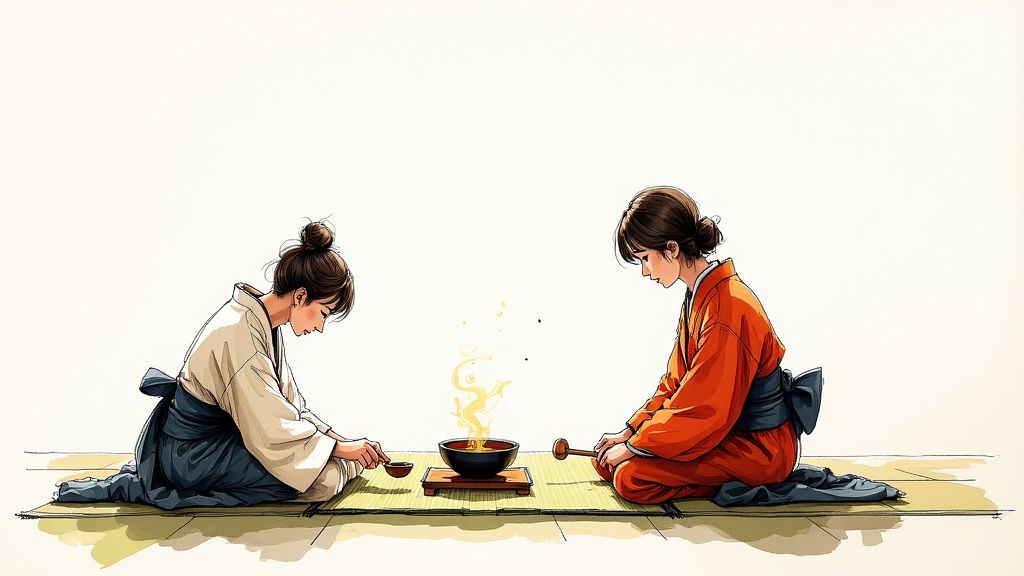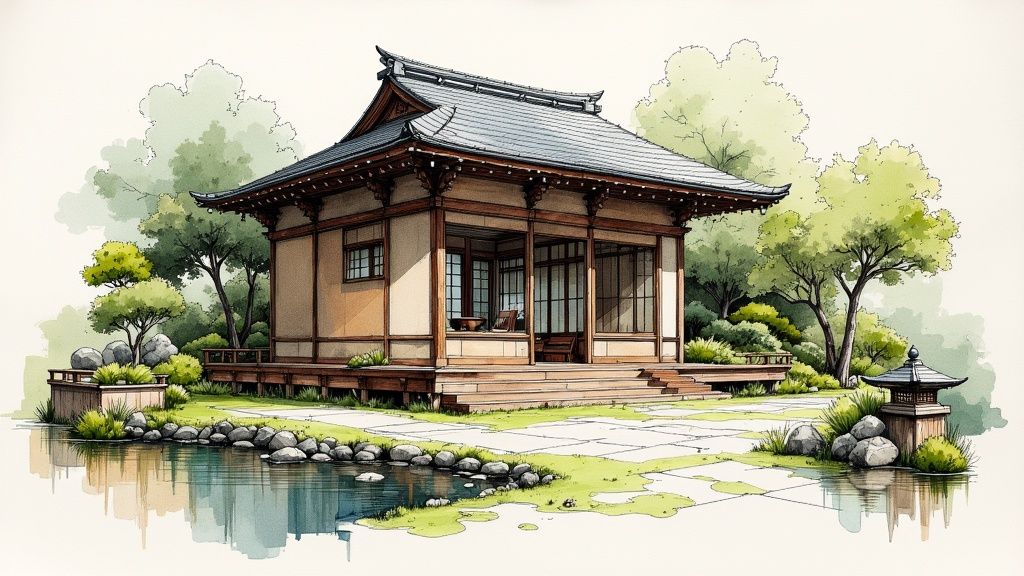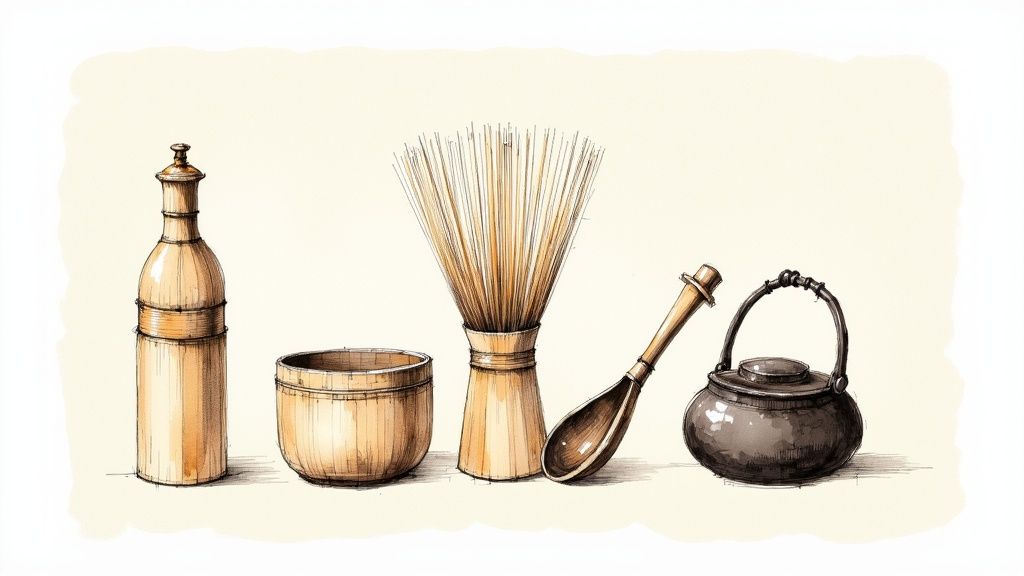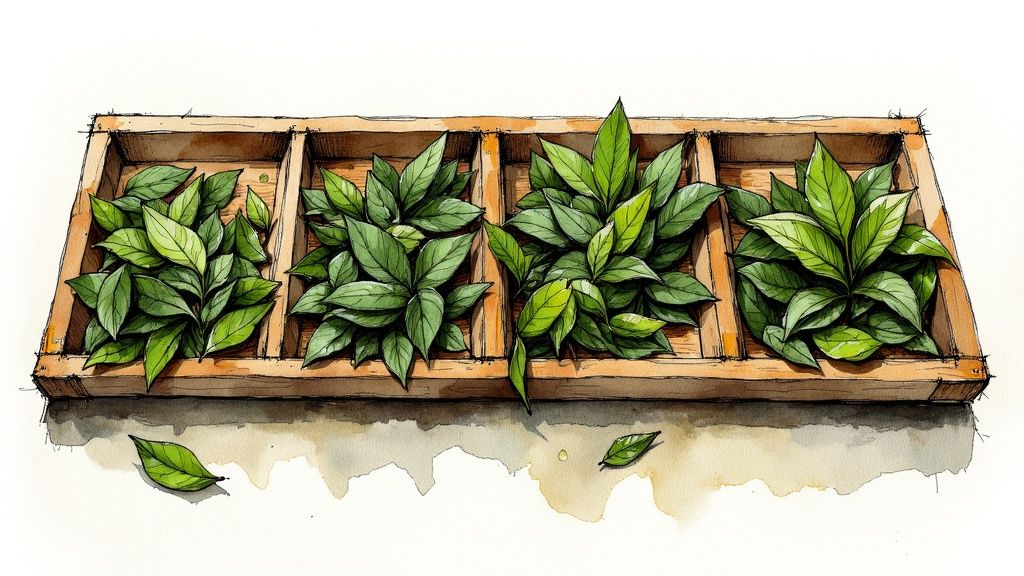Understanding the Sacred Origins of Tea in Japan

The rich history of Japanese tea begins not in Japan itself, but in China. Buddhist monks traveling between the two countries first brought tea to Japanese shores while seeking religious texts and wisdom. These early tea pioneers recognized how tea could deepen their meditation practice, so they carefully transported seeds and plant cuttings back to Japan to grow in temple gardens. At first, tea served primarily religious and medicinal purposes. A significant early moment came in 815 CE, when the monk Eichu served tea to Emperor Saga, marking tea's first entry into Japan's imperial court.
From Monastery Gardens to Imperial Courts
The deep connection between tea and Buddhism shaped how tea culture grew in Japan. Buddhist monasteries became the first centers for growing and preparing tea, where monks transformed the simple act of tea preparation into a mindful practice. The careful attention needed to cultivate tea plants aligned perfectly with Zen Buddhist teachings about presence and concentration. This thoughtful approach extended beyond just growing tea – it influenced every aspect of how tea was prepared and served. These early practices laid the foundation for the detailed tea ceremonies that would later become central to Japanese culture. Learn more in our article about The Origin of Japanese Tea Ceremony.
The Chinese Influence on Japanese Tea Culture
While Japanese tea culture has clear roots in Chinese traditions, it developed its own unique character over time. The Japanese first learned tea cultivation methods, preparation techniques, and tea varieties from China. However, as tea became established in Japan, it gradually took on distinctly Japanese qualities. This evolution is most visible in the development of Japanese tea varieties and the highly detailed Japanese tea ceremony. Though inspired by Chinese customs, the Japanese tea ceremony grew into something uniquely Japanese, reflecting local artistic values and philosophical ideas.
The Evolution of Tea in Japanese Society
As centuries passed, tea moved beyond temples and imperial halls to touch all levels of Japanese society. By the 1300s, both warriors and merchants had embraced tea drinking and early forms of tea ceremony. This broader adoption led to new tea varieties and brewing methods. For instance, sencha, a steamed green tea, became Japan's most popular tea variety and changed how tea was produced. Tea smoothly wove itself into every aspect of Japanese life, influencing everything from social customs to art and architecture. This deep appreciation for tea continues today, as tea practices both honor their historical roots and adapt to modern life.
Mastering the Art of Traditional Tea Ceremony

The Japanese tea ceremony embodies far more than just serving tea – it's an intricate ritual that weaves together history, philosophy and aesthetics into a meaningful cultural practice. Each element, from the careful preparation of tea to the mindful interactions between host and guests, creates an experience that has captivated people for centuries.
The Guiding Principles of Sen Rikyū
Sen Rikyū, the influential 16th-century tea master, shaped the ceremony by establishing its fundamental principles. At its heart is wabi-sabi – finding beauty in simplicity and imperfection. This philosophy touches everything from the humble tea room design to the handcrafted tea bowls (chawan) whose natural flaws are considered unique marks of character. These aren't just abstract concepts – they offer practical guidance for conducting the ceremony while encouraging participants to find meaning in life's simple moments.
Decoding the Choreography of Japanese Traditional Tea
Each movement in the tea ceremony carries deeper significance beyond just making tea. From cleaning the utensils to whisking the matcha powder, every action flows with purpose. This careful attention ensures both perfect tea preparation and creates an atmosphere of shared focus between host and guests. The ceremony unfolds in distinct phases, building toward the moment when everyone drinks tea together – a simple act that creates genuine human connection.
Balancing Tradition and Personal Expression
While strict protocols guide the tea ceremony, practitioners can still express themselves thoughtfully. This shows up in their choice of tea bowls, seasonal flower arrangements (ikebana), and displayed calligraphy. Modern tea hosts work to honor traditional forms while bringing their own perspective – perhaps through selecting specific tea varieties like matcha or gyokuro. This blend of old and new keeps the ceremony relevant while preserving its essential spirit.
The Enduring Relevance of Japanese Traditional Tea
In our rushed modern lives, the tea ceremony offers a chance to slow down and be present. Its emphasis on mindfulness and appreciation for simple beauty continues to draw people seeking meaning and peace. Through focused ritual and connection with others, the ceremony helps us step outside our daily concerns to experience something timeless. This explains why both traditionalists and newcomers still find value in this centuries-old practice.
Exploring Japan's Distinguished Tea Varieties
Japanese tea culture offers an incredible range of flavors and aromas – from ceremonial matcha to everyday sencha. While the growing conditions and terroir play important roles, it's the careful processing methods that truly define each tea's unique character. Let's explore the fascinating world of Japanese teas and what makes each variety special.
The Spectrum of Japanese Traditional Tea
While most Japanese teas fall under the green tea category, ranging from subtle to bold flavors, you'll also find smaller but notable productions of oolong and black teas within Japanese tea culture.
- Gyokuro: Known as "jade dew," gyokuro stands out for its rich umami flavor and vivid green color. Tea farmers shade the plants for several weeks before harvest, boosting chlorophyll levels for a sweeter, less astringent taste. This labor-intensive process makes it one of Japan's most prized and expensive teas.
- Sencha: Making up about 80% of Japan's tea production, sencha is the go-to daily green tea. Its crisp, refreshing taste comes from steaming the leaves, which locks in the bright green color and creates those signature grassy notes that Japanese tea lovers enjoy.
- Matcha: Unlike other teas that are steeped, matcha is made by whisking finely ground tea powder directly in hot water. This method not only creates a rich, creamy texture but also means you consume the whole tea leaf, maximizing its health benefits.
- Hojicha: This unique tea gets its toasty, nutty flavor and reddish-brown color from roasting. The process naturally reduces caffeine content, making it perfect for evening drinking or for those who want to limit their caffeine intake.
- Genmaicha: By blending green tea with roasted brown rice, genmaicha creates a warming, popcorn-like aroma with a gentle, savory taste. Its approachable flavor profile makes it an excellent starting point for those new to Japanese teas.
Processing: The Key to Distinctive Flavors
The magic of Japanese tea lies in its processing methods. For example, when making sencha, careful steaming stops oxidation, preserving both the tea's bright color and fresh, vegetal notes. In contrast, roasting hojicha creates a completely different experience with its sweet, smoky profile. These variations in processing show how small changes can create dramatically different results in the final cup.
Cultivating Quality: From Leaf to Cup
Japanese tea growers combine time-honored traditions with careful attention to growing conditions. They consider everything from soil type to altitude and sunlight exposure. Expert tea masters watch over the plants throughout the growing season, knowing that even small changes in cultivation can affect the final product's taste and aroma. This careful attention to detail reflects Japanese tea culture's deep respect for both nature and craftsmanship, resulting in teas that offer unique and memorable drinking experiences.
Understanding Japanese Tea Philosophy

Japanese tea ceremonies are more than just preparing and drinking tea – they embody centuries of cultural wisdom and spiritual practice. At their core, these ceremonies bring people together to share in a moment of reflection and connection over a bowl of carefully prepared matcha. Each gesture, each utensil, and each interaction carries deep meaning that continues to resonate with people today.
Finding Beauty in Imperfection
At the heart of Japanese tea philosophy lies wabi-sabi – the appreciation of beauty in what is simple, imperfect, and natural. You might notice a tea bowl's slight asymmetry or the way its glaze has developed fine cracks over years of use. Rather than seeing these as flaws, practitioners view them as elements that give each piece its unique character and story. This extends to the tea room itself, where natural materials and understated decor create an atmosphere of rustic elegance.
Creating Balance Through Design
The tea room brings together several art forms to create a harmonious whole. Fresh flowers arranged through ikebana, a thoughtfully chosen calligraphy scroll in the tokonoma alcove, and carefully selected tea implements work together to establish a sense of peace and visual balance. This attention to detail helps guests transition from the outside world into a more contemplative state. The interactions between host and guests follow time-honored customs that build connection and mutual respect.
Finding Peace in Each Moment
Every movement in the tea ceremony has purpose. From cleaning the utensils to whisking the matcha, each step requires complete focus and care. This deliberate approach naturally draws everyone present into the current moment, setting aside daily concerns to fully experience the simple act of sharing tea. The ceremony becomes a form of active meditation, allowing participants to find stillness within themselves while connecting with others.
Bringing Tea Philosophy Into Modern Life
The principles of Japanese tea ceremonies offer valuable lessons for finding balance in our busy lives. Taking time to slow down, appreciate simple beauty, and connect with others over tea can provide much-needed moments of calm. Even without following formal ceremony protocols, we can incorporate these ideas into our own tea practice. This might mean choosing a special tea bowl, preparing tea with focused attention, or simply pausing to fully experience the tea's aroma and taste. These small rituals remind us to find meaning in life's quiet moments.
Unlocking the Natural Benefits of Traditional Japanese Tea
Japanese tea has stood the test of time, offering remarkable health benefits validated by both centuries of traditional use and modern scientific research. Beyond just a beverage, the mindful cultivation, precise processing methods, and thoughtful preparation practices work together to bring out the most beneficial properties of each variety.
The Science Behind the Steep
Research has revealed the powerful compounds responsible for Japanese tea's health-promoting effects. Green tea contains an abundance of beneficial substances, with polyphenols like catechins being especially important. One catechin called EGCG stands out – studies show it neutralizes harmful free radicals about 100 times more effectively than vitamin C. This exceptional antioxidant activity helps shield cells from damage that can lead to various health issues. The scientific evidence supports what traditional wisdom has long known about green tea's positive effects on wellbeing.
Brewing Methods and Bioactive Compounds
The way Japanese tea is prepared plays a key role in accessing its beneficial compounds. The water temperature and steeping duration directly affect how many catechins and antioxidants are extracted from the leaves. Take matcha, for example – since you consume the entire powdered tea leaf rather than just steeping the leaves like with sencha or gyokuro, you get a more concentrated dose of the tea's nutrients. This shows how traditional preparation methods developed to maximize both taste and health benefits.
Ceremonial Practices and Mindfulness
The meditative aspects of Japanese tea ceremonies add another dimension of benefit beyond the nutritional properties. Taking time to mindfully prepare and savor the tea creates a peaceful moment that can ease stress and sharpen mental focus. Paying attention to the tea's aroma and flavor while sharing the experience with others helps cultivate presence and connection. The ceremony exemplifies how Japanese tea culture nurtures both physical and emotional wellbeing.
Traditional Preparation: Maximizing Health and Sensory Experience
Every step in Japanese tea production – from growing to processing to brewing – has been refined over generations to optimize both therapeutic value and drinking pleasure. For example, shading gyokuro leaves before harvest boosts chlorophyll and creates a sweeter, more savory flavor while increasing certain beneficial compounds. The roasting process that gives hojicha its signature toasted taste also naturally reduces caffeine, making it perfect for evening drinking. These time-tested methods demonstrate how Japanese tea traditions skillfully balance health benefits with sensory enjoyment.
Preserving Tea Traditions in Contemporary Times

Japanese tea culture beautifully balances respect for ancient traditions with natural evolution. As tea practices adapt to modern sensibilities, the core principles of mindfulness, respect, and harmony remain firmly rooted. Modern tea masters thoughtfully incorporate new approaches while preserving essential elements – making tea ceremonies more approachable without losing their soul. This organic growth keeps Japanese tea vibrant and meaningful for each new generation.
Bridging the Gap Between Ancient Rituals and Modern Life
Today's fast pace can seem at odds with the deliberate movements and quiet contemplation of traditional tea ceremony. Yet practitioners have found practical ways to share tea's benefits with busy people. Some offer abbreviated ceremonies that capture key elements in a shorter timeframe. Others host introductory workshops where beginners can experience tea's meditative qualities without committing to extensive training. These adaptations help more people discover how tea practice can bring balance to hectic schedules.
Technology's Role in Preserving and Sharing Tea Culture
Digital tools have become unexpected allies in keeping tea traditions alive. Tea masters use social media and online platforms to demonstrate proper techniques and connect with students worldwide. Virtual classes make learning accessible across distances. Meanwhile, digital archives preserve historical documents, ceremonial objects, and tea wisdom for future generations. Rather than diminishing tea's intimacy, technology helps build global communities of tea enthusiasts who share knowledge and appreciation.
The Future of Japanese Traditional Tea: A Blend of Old and New
For tea traditions to thrive, they must remain authentic while welcoming new practitioners. Leading tea schools maintain high standards in teaching traditional methods while creating an open, inclusive environment. They recognize that preservation happens through sharing – passing techniques and philosophies to those eager to learn. This balanced approach keeps traditions vital and growing.
Finding Your Path in Japanese Tea Culture
Japanese tea offers many ways to participate, whether you're curious to learn basics or ready for deeper study:
- Local Tea Houses and Cultural Centers: Many neighborhoods have tea spaces that offer ceremonies and workshops. These venues provide direct experience while connecting you with fellow enthusiasts.
- Online Resources and Virtual Classes: Digital platforms make it simple to begin learning about tea from anywhere, with video lessons and online communities offering guidance and support.
- Tea Farms and Plantations: Visiting tea growing regions gives unique insight into cultivation methods and processing. You'll gain deeper appreciation for the care invested in each cup.
This living tradition continues to touch new lives while maintaining its essence. As tea practices naturally evolve, they demonstrate remarkable ability to remain meaningful across generations and cultures.
Ready to start your tea journey? Discover authentic Japanese teas at matcha-tea.com and begin exploring this rich tradition.
